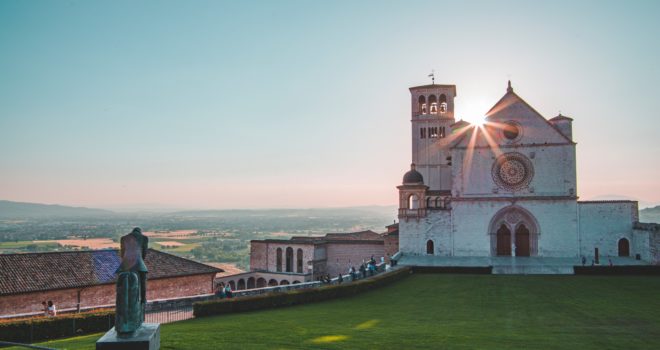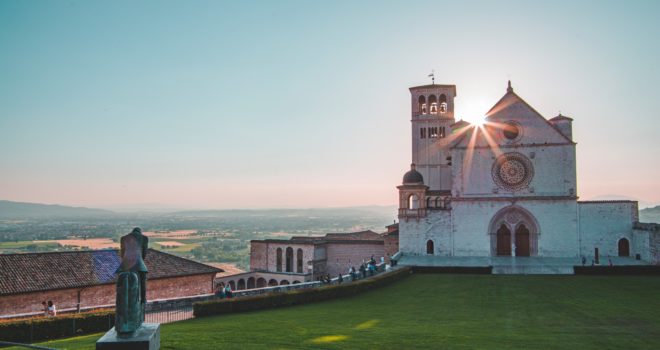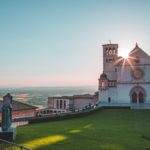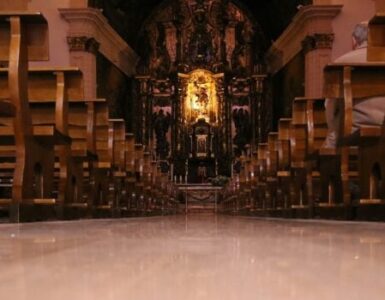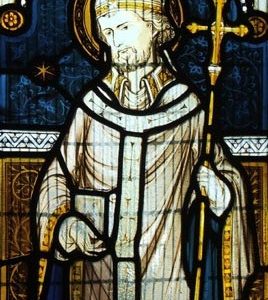Franciscan history began with the Assisi birth of Giovanni di Bernardone, soon called Francesco, around 1181 AD.
Twelve centuries earlier, Assisi was a deeply entrenched Roman colony, with its own pagan temple. The world would soon change with the birth of the Christ Child. Yet, the spread of Christianity throughout Italy would be a long, laborious process, filled with persecutions and martyrdom.
According to legend, one of the earliest to preach Christianity in Assisi was Saint Crispoldus who, by one account, was sent out to evangelize by Saint Peter in 58 AD, and by another account was martyred during the Third Century reign of Emperor Maximian, tortured and killed for refusing to sacrifice to the Roman gods. More certain than the dates and lifespan of Crispoldus is that he served as Bishop of Bettona, and preached in nearby towns, including Assisi.
Assisi’s cathedral bears the name of Saint Rufinus, the city’s own first bishop. Rufinus, too, ran afoul of the Roman authorities. In 238 AD, a millstone was tied around his neck, and he was drowned in the nearby Chiascio River. Saint Rufinus was succeeded as bishop by Saint Victorinus, who met a similar fate, being martyred near the Tescio River outside the city.
Saint Felician, from the Umbrian town of Foligno, was one of the first native northern Italians to be ordained bishop. He also was the first bishop to wear a pallium, a liturgical vestment symbolizing participation in papal authority. During the Third Century he, too, gained converts, although he was expelled from Assisi by the Roman governor for preaching. In his old age, he died in chains while being taken as a prisoner to Rome. Today, a small chapel dedicated to Saint Felician stands along the path between Assisi and San Damiano, where he is said to have placed a crucifix upon being expelled from the city.
In the Fourth Century, a group of hermits from the Holy Land built a chapel on a small portion of land in the valley below Assisi. They had brought with them relics from the tomb of Mary, and named the chapel after Our Lady of the Angels. By 576 AD, the chapel was in the hands of Benedictine monks, but would eventually fall into a state of disrepair.
Over the next few centuries, Benedictine activity increased in the region. At some point following the time of Saint Benedict (480 – 547 AD), most probably the Seventh or Eighth Century, an Abbey of Saint Benedict was established near Assisi on Mount Subasio. Monks from the abbey would become influential in the region, developing churches and owning property. A second Benedictine abbey, named after Saint Peter, was established in the city around 970 AD.
Also in Assisi, during this broad time frame, an original Church of Santa Maria Maggiore was constructed over Roman ruins, as was the original Church of San Rufino, Assisi’s eventual cathedral.
By the late Twelfth Century, Christianity was well established, with churches large and small in and around Assisi. The monks of the Abbey of Saint Benedict had, in 1071 AD, established the Priory of Saint Paul, which still stands near the center of the city. They also owned the Church of San Damiano, in need of repairs, with its distinct Romanesque cross. And, by 1166 AD, the small “working people’s church” of Santo Stefano had been constructed, where Sunday masses are celebrated to this day.
Into this world, during the reign of Holy Roman Emperor Frederick I, and with much tension between a growing middle class and the nobility, and with war, leprosy, and political unrest ever on the horizon, Francis was born. While he was still young, Assisi sisters Clare and Caterina Offreduccio were born, destined to become Saints Clare and Agnes (a name given to Caterina by Francis, as she was “gentle as a lamb”). Francis and Clare were baptized at the Church of San Rufino. Francis was raised in the Catholic faith at the Church of Saint George, which stood at the current site of the Basilica of Saint Clare. The Offreduccio sisters lived next to and attended Masses at the Church of San Rufino.
While Catholicism had taken hold in Assisi, all was not well for the faithful. The Church was emerging from a long period of corruption and schism, of tension between church and secular leaders. It still had a long way to go when Francis, kneeling below the Romanesque cross at the broken down church of San Damiano, heard the voice of Christ say, “Francis, go rebuild My house; as you see, it is all being destroyed.”
At first, Francis literally worked to rebuild churches, starting with San Damiano. In time, he and his followers would embark on helping to repair the universal Church. As Francis pursued his calling, the Benedictines gave him permission to repair the small chapel, built eight centuries earlier by the Holy Land hermits and dedicated to Mary, Our Lady of the Angels, and use it as a home for his new order. In reference to the small portion of land on which it stood, the chapel was called the “Porziuncola,” and remains to this day the center of Franciscan life.
In the early Thirteenth Century, after a millennium of saintly people coming to evangelize Assisi, the faithful of Assisi began going out to evangelize the world. As a result, many thousands of Franciscans and Poor Clares continue to bring faith, hope and love to all humanity.
✠
Photo by Enrico Tavian on Unsplash


